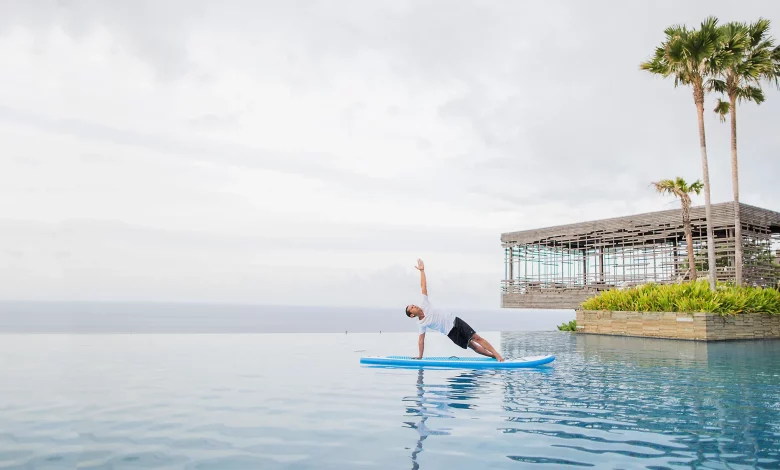Finding Balance: Yoga for Kayakers

Kayaking, a thrilling water sport, demands physical prowess, and an often overlooked aspect is the significance of balance. Mastering balance is not only crucial for navigating the waters seamlessly but also for preventing injuries and enhancing overall performance. In this article, we delve into the world of yoga and its remarkable potential to elevate the balance game for kayakers. Let’s embark on a journey to discover how the fusion of kayaking and yoga can harmonize body and mind.
The Physical Demands of Kayaking
Muscle Symphony on Water:
Kayaking engages various muscle groups, demanding both strength and endurance. Paddling through water requires substantial upper body strength, particularly in the shoulders and arms. The constant torso rotation engages the core muscles, emphasizing the importance of a strong and stable midsection. Additionally, the lower body plays a role in maintaining balance, especially during rapid movements.
Core Strength and Stability:
The core muscles act as the powerhouse for kayakers, providing stability and facilitating efficient paddling. A strong core not only improves balance but also helps prevent back injuries—a common concern for kayakers due to the repetitive nature of paddling.
Challenges to Balance:
Kayakers often face challenges like unpredictable water currents, sudden changes in weather, and varying terrains. These factors intensify the need for robust balance, making it a fundamental skill for both novice and experienced paddlers.
Understanding Yoga for Kayakers
Holistic Approach to Well-being:
Yoga, an ancient practice, extends beyond physical exercise, offering a holistic approach to well-being. It integrates breath control, meditation, and physical postures, promoting mental clarity and enhancing overall fitness. For kayakers, this holistic approach translates into improved concentration, reduced stress, and enhanced performance on the water.
Complementary Dynamics:
The synergy between yoga and kayaking lies in their complementary dynamics. Yoga addresses the physical demands of kayaking by targeting specific muscle groups while also fostering mental resilience a valuable asset in the face of challenging water conditions.
Evolution of Yoga:
Yoga has a rich history that spans thousands of years, evolving from ancient traditions to a diverse range of modern practices. The integration of yoga into various sports and activities, including kayaking, highlights its adaptability and enduring relevance in promoting physical and mental well-being.
Key Yoga Poses for Kayakers
Warrior Pose (Virabhadrasana):
This dynamic standing pose is a cornerstone for building lower body strength and improving stability. The extended reach and firm grounding mimic the movements required during kayaking, enhancing the connection between body and boat. Practicing Warrior Pose regularly contributes to stronger legs and a more stable lower body foundation.
Downward Dog (Adho Mukha Svanasana):
Downward Dog is a versatile pose that focuses on stretching and strengthening multiple muscle groups simultaneously. For kayakers, it aids in improving flexibility, particularly in the hamstrings and shoulders. This pose also serves as an excellent way to relieve tension built up in the upper body during extended paddling sessions.
Boat Pose (Navasana):
Targeting the core muscles, Boat Pose is an invaluable addition to a kayaker’s yoga routine. A robust core is essential for maintaining balance on the water, and this pose helps strengthen the abdominal muscles. Regular practice enhances core stability, reducing the risk of injuries and contributing to overall balance improvement.
Tree Pose (Vrikshasana):
Balance is not only about physical strength but also mental focus. Tree Pose challenges kayakers to find stability on one leg while improving concentration and balance. The pose encourages a connection with nature, aligning perfectly with the essence of kayaking a sport deeply rooted in the outdoors.
Cat-Cow Stretch (Marjaryasana-Bitilasana):
This flowing sequence of movements helps kayakers improve spine flexibility and alleviate stiffness. The rhythmic motion of arching and rounding the back mimics the natural movements involved in paddling, making it an excellent warm-up or cooldown exercise for kayakers before and after hitting the water.
Bridge Pose (Setu Bandhasana):
Kayakers often experience strain in the lower back due to the prolonged sitting position in a kayak. Bridge Pose targets the back, glutes, and hamstrings, providing relief and strengthening these areas. Incorporating this pose into a regular yoga routine contributes to a more resilient and balanced lower body.
Incorporating Yoga into Kayakers’ Routine
Pre-Paddling Warm-up:
Before embarking on a kayaking adventure, it’s crucial to prepare the body for the physical demands ahead. A targeted warm-up routine that includes dynamic stretches and the selected yoga poses can activate the necessary muscle groups, enhance flexibility, and mentally prepare kayakers for the journey ahead.
Post-Paddling Cooldown:
After the exhilaration on the water, a proper cooldown is essential to prevent stiffness and aid in recovery. Gentle stretches, relaxation poses, and focused breathing help release tension accumulated during kayaking. This cooldown ritual not only enhances flexibility but also promotes mental relaxation, contributing to an overall sense of well-being.
Weekly Yoga Sessions:
To reap the full benefits of yoga for kayaking, incorporating regular yoga sessions into the weekly routine is key. These sessions can focus on the specific poses highlighted earlier, along with additional poses that address individual needs and goals. Consistency is paramount for sustained improvement in both balance and overall fitness.
Tips for Busy Kayakers:
In the hustle and bustle of daily life, finding time for yoga can be challenging. However, even brief, focused sessions can make a significant difference. Kayakers with tight schedules can explore quick routines that target specific muscle groups and promote balance. The key is to make yoga a sustainable and enjoyable part of the overall fitness routine.
Mental Focus and Mindfulness
Role of Mental Focus in Kayaking:
Kayaking is not just a physical activity; it requires sharp mental focus and awareness. Navigating through water currents, making split-second decisions, and adapting to changing conditions demand a heightened state of concentration. Yoga, with its emphasis on mindfulness and breath control, becomes a valuable tool for enhancing the mental aspects of kayaking.
Mindfulness Techniques for Improved Performance:
Yoga introduces practitioners to mindfulness techniques that can be directly applied to kayaking. Techniques such as mindful breathing and meditation foster a calm and focused mindset. By incorporating these practices, kayakers can cultivate the ability to stay present in the moment, enhancing their decision-making and responsiveness on the water.
Yoga’s Contribution to Mental Well-being:
Beyond the immediate benefits for kayaking, yoga contributes significantly to mental well-being. The practice has been shown to reduce stress, anxiety, and depression, providing kayakers with a mental sanctuary amidst the challenges of their sport. A balanced mental state translates into better resilience and adaptability—a critical aspect for any kayaker.
Guided Meditation for Kayakers:
Guided meditation sessions tailored for kayakers can further amplify the mental benefits of yoga. These sessions can focus on visualization techniques, positive affirmations, and mental imagery related to kayaking scenarios. By consistently engaging in guided meditation, kayakers can develop a robust mental foundation that enhances their overall performance on the water.
Expert Tips and Insights
Interviews with Experienced Kayakers:
To gain real-world insights, we spoke with experienced kayakers who have successfully incorporated yoga into their routines. According to Sarah Turner, a seasoned kayaker and yoga enthusiast, “Yoga has been a game-changer for me. It’s not just about physical strength; it’s about being in tune with your body and the water. The mental benefits are equally important, helping me stay calm and focused during challenging paddling situations.”
Input from Yoga Instructors:
We also sought input from yoga instructors specializing in sports enhancement. Emily Rodriguez, a certified yoga instructor, emphasizes the importance of a tailored approach: “Each kayaker is unique, and their yoga routine should reflect that. Customizing poses based on individual needs and focusing on breath awareness can make a significant impact on their balance and overall well-being.”
Common Mistakes to Avoid:
While integrating yoga into kayaking brings numerous benefits, it’s essential to be aware of common mistakes. Rushing through poses, neglecting proper form, or pushing beyond one’s limits can lead to injuries. Being mindful of individual capabilities and gradually progressing in intensity ensures a safe and effective integration of yoga into a kayak’s routine.
Personal Success Stories:
Stories of personal success serve as powerful motivators. We’ve gathered inspiring narratives from kayakers who have witnessed transformative changes in their balance, strength, and mental resilience through the consistent practice of yoga. These success stories highlight the universal applicability of yoga in enhancing the kayaking experience.
Safety Considerations
Precautions for Individuals with Pre-existing Conditions:
Before embarking on a yoga routine for kayakers, it’s crucial to consider individual health conditions. Those with pre-existing injuries or medical conditions should consult with healthcare professionals before starting a new exercise regimen. Yoga instructors experienced in adapting poses for specific needs can provide valuable guidance to ensure a safe practice.
Importance of Proper Form:
Maintaining proper form in yoga poses is paramount, especially for kayakers seeking to improve balance. Incorrect alignment can lead to injuries or strain. Utilizing mirrors, online tutorials, or attending classes with experienced instructors can help kayakers ensure that they are performing poses correctly and reaping the full benefits without compromising safety.
Gradual Progression for Injury Prevention:
The journey to improved balance through yoga is a gradual process. Pushing too hard, too soon can result in injuries and setbacks. Kayakers should embrace a patient and progressive approach, gradually increasing the intensity and duration of their yoga practice. Consistency and mindful progression are key to reaping the long-term benefits without unnecessary strain.
Consulting with Healthcare Professionals:
Before embarking on a new fitness routine, including yoga, kayakers should consult with healthcare professionals. This is especially important for individuals with existing health concerns or those recovering from injuries. Healthcare professionals can provide personalized advice, ensuring that the chosen yoga routine aligns with individual health goals and restrictions.
Resources for Kayakers Interested in Yoga
Recommended Yoga Classes or Instructors:
Finding the right yoga class or instructor is essential for kayakers looking to embark on their yoga journey. Local studios, online platforms, and community centers often offer classes tailored to different skill levels. Look for instructors with experience in sports-specific yoga or those who understand the unique needs of kayakers.
Online Platforms for Yoga Sessions:
For kayak with busy schedules or limited access to local classes, online platforms offer a wealth of yoga sessions. Websites and apps dedicated to yoga often provide routines specifically designed for enhancing balance, flexibility, and mental focus—ideal for complementing kayaking activities.
Books and Articles on the Connection between Yoga and Kayaking:
Exploring literature on the connection between yoga and kayaking can provide valuable insights. Books authored by experienced kayak, yoga instructors, or sports scientists can offer a deeper understanding of the synergies between the two practices. Additionally, online articles and publications can provide accessible information for those eager to learn more.
Relevant Social Media Groups and Forums:
Engaging with like-minded individuals can be motivating and informative. Joining social media groups or forums dedicated to kayaking and yoga creates a sense of community. Here, kayakers can share experiences, seek advice, and discover new resources for integrating yoga into their routines.
Conclusion
In this comprehensive exploration of “Finding Balance: Yoga for Kayak,” we’ve navigated the waters of physical demands, yoga poses, mental focus, expert insights, and safety considerations. The integration of yoga into a kayak’s routine offers not just improved balance and strength but a holistic approach to well-being.
As we conclude, remember that the journey to finding balance is ongoing. Consistent practice, mindfulness, and a personalized approach will guide kayak toward optimal performance on the water and a deeper connection with their bodies and surroundings.









